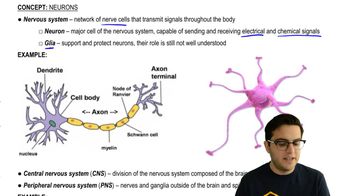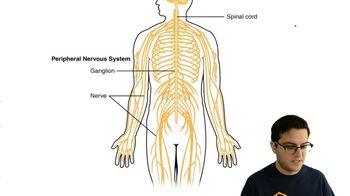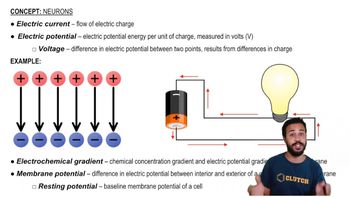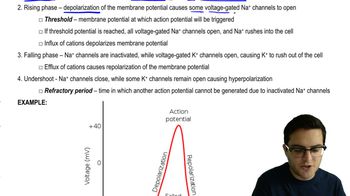Table of contents
- 1. Introduction to Biology2h 42m
- 2. Chemistry3h 40m
- 3. Water1h 26m
- 4. Biomolecules2h 23m
- 5. Cell Components2h 26m
- 6. The Membrane2h 31m
- 7. Energy and Metabolism2h 0m
- 8. Respiration2h 40m
- 9. Photosynthesis2h 49m
- 10. Cell Signaling59m
- 11. Cell Division2h 47m
- 12. Meiosis2h 0m
- 13. Mendelian Genetics4h 44m
- Introduction to Mendel's Experiments7m
- Genotype vs. Phenotype17m
- Punnett Squares13m
- Mendel's Experiments26m
- Mendel's Laws18m
- Monohybrid Crosses19m
- Test Crosses14m
- Dihybrid Crosses20m
- Punnett Square Probability26m
- Incomplete Dominance vs. Codominance20m
- Epistasis7m
- Non-Mendelian Genetics12m
- Pedigrees6m
- Autosomal Inheritance21m
- Sex-Linked Inheritance43m
- X-Inactivation9m
- 14. DNA Synthesis2h 27m
- 15. Gene Expression3h 20m
- 16. Regulation of Expression3h 31m
- Introduction to Regulation of Gene Expression13m
- Prokaryotic Gene Regulation via Operons27m
- The Lac Operon21m
- Glucose's Impact on Lac Operon25m
- The Trp Operon20m
- Review of the Lac Operon & Trp Operon11m
- Introduction to Eukaryotic Gene Regulation9m
- Eukaryotic Chromatin Modifications16m
- Eukaryotic Transcriptional Control22m
- Eukaryotic Post-Transcriptional Regulation28m
- Eukaryotic Post-Translational Regulation13m
- 17. Viruses37m
- 18. Biotechnology2h 58m
- 19. Genomics17m
- 20. Development1h 5m
- 21. Evolution3h 1m
- 22. Evolution of Populations3h 52m
- 23. Speciation1h 37m
- 24. History of Life on Earth2h 6m
- 25. Phylogeny2h 31m
- 26. Prokaryotes4h 59m
- 27. Protists1h 12m
- 28. Plants1h 22m
- 29. Fungi36m
- 30. Overview of Animals34m
- 31. Invertebrates1h 2m
- 32. Vertebrates50m
- 33. Plant Anatomy1h 3m
- 34. Vascular Plant Transport1h 2m
- 35. Soil37m
- 36. Plant Reproduction47m
- 37. Plant Sensation and Response1h 9m
- 38. Animal Form and Function1h 19m
- 39. Digestive System1h 10m
- 40. Circulatory System1h 57m
- 41. Immune System1h 12m
- 42. Osmoregulation and Excretion50m
- 43. Endocrine System1h 4m
- 44. Animal Reproduction1h 2m
- 45. Nervous System1h 55m
- 46. Sensory Systems46m
- 47. Muscle Systems23m
- 48. Ecology3h 11m
- Introduction to Ecology20m
- Biogeography14m
- Earth's Climate Patterns50m
- Introduction to Terrestrial Biomes10m
- Terrestrial Biomes: Near Equator13m
- Terrestrial Biomes: Temperate Regions10m
- Terrestrial Biomes: Northern Regions15m
- Introduction to Aquatic Biomes27m
- Freshwater Aquatic Biomes14m
- Marine Aquatic Biomes13m
- 49. Animal Behavior28m
- 50. Population Ecology3h 41m
- Introduction to Population Ecology28m
- Population Sampling Methods23m
- Life History12m
- Population Demography17m
- Factors Limiting Population Growth14m
- Introduction to Population Growth Models22m
- Linear Population Growth6m
- Exponential Population Growth29m
- Logistic Population Growth32m
- r/K Selection10m
- The Human Population22m
- 51. Community Ecology2h 46m
- Introduction to Community Ecology2m
- Introduction to Community Interactions9m
- Community Interactions: Competition (-/-)38m
- Community Interactions: Exploitation (+/-)23m
- Community Interactions: Mutualism (+/+) & Commensalism (+/0)9m
- Community Structure35m
- Community Dynamics26m
- Geographic Impact on Communities21m
- 52. Ecosystems2h 36m
- 53. Conservation Biology24m
45. Nervous System
Neurons and Action Potentials
Problem 16f`
Textbook Question
Certain species of frogs in the genus Phyllobates have a powerful defensive adaptation—their skin can secrete a milky fluid that contains an extremely toxic compound called batrachotoxin (BTX). These frogs, which are found in Colombia, are known as poison dart frogs because some indigenous Colombian hunters coat the tips of their blowgun darts with the frogs' skin secretions. An animal hit by one of these darts dies quickly.
What is the mechanism of action of BTX?
Although BTX is a powerful antipredator poison, one snake species in Colombia eats poison dart frogs. Suggest a hypothesis that might explain how the snake is resistant to the toxin.
 Verified step by step guidance
Verified step by step guidance1
Understand the mechanism of action of batrachotoxin (BTX): BTX is a potent toxin that affects the nervous system by binding to and permanently opening voltage-gated sodium channels in nerve cells. This causes a continuous influx of sodium ions, leading to persistent depolarization of the nerve cell membrane, which disrupts normal nerve signaling and can result in paralysis and death.
Consider the ecological context: Poison dart frogs use BTX as a defense mechanism against predators. However, some predators, like certain snake species, have evolved resistance to this toxin, allowing them to prey on these frogs.
Formulate a hypothesis for the snake's resistance: One possible hypothesis is that the snake has evolved a mutation in the sodium channels that prevents BTX from binding effectively. This mutation could alter the structure of the sodium channels, reducing the toxin's ability to open them permanently.
Explore alternative hypotheses: Another hypothesis could be that the snake has developed a detoxification mechanism, such as enzymes that degrade BTX before it can affect the nervous system. Alternatively, the snake might have a physiological adaptation that allows it to tolerate higher levels of sodium influx without detrimental effects.
Consider evolutionary implications: The snake's resistance to BTX likely provides a selective advantage, allowing it to exploit a food source that is unavailable to other predators. This resistance could have evolved through natural selection, where individuals with mutations or adaptations that confer resistance to BTX are more likely to survive and reproduce.
 Verified video answer for a similar problem:
Verified video answer for a similar problem:This video solution was recommended by our tutors as helpful for the problem above
Video duration:
1mPlay a video:
Was this helpful?
Key Concepts
Here are the essential concepts you must grasp in order to answer the question correctly.
Batrachotoxin (BTX)
Batrachotoxin (BTX) is a potent neurotoxin found in certain species of poison dart frogs. It works by binding to voltage-gated sodium channels in nerve cells, forcing them to remain open. This disrupts normal nerve function, leading to paralysis and potentially fatal outcomes. Understanding BTX's mechanism is crucial for comprehending its role as a defensive adaptation.
Voltage-gated Sodium Channels
Voltage-gated sodium channels are essential for the generation and propagation of action potentials in neurons. They open in response to changes in membrane potential, allowing sodium ions to flow into the cell, which is critical for nerve signal transmission. BTX affects these channels by keeping them open, disrupting normal nerve function and leading to paralysis.
Recommended video:
Guided course
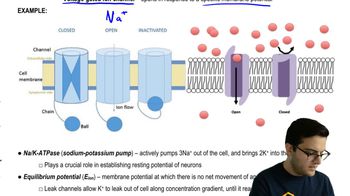
Ion Channels and Pumps
Toxin Resistance in Predators
Toxin resistance in predators, such as the snake species that preys on poison dart frogs, may involve genetic mutations or adaptations that alter the structure or function of sodium channels, preventing BTX binding. Alternatively, the snake might possess detoxifying enzymes or transport mechanisms that neutralize or expel the toxin, allowing it to safely consume the frogs.
Recommended video:
Guided course

Introduction to Pathogenic Toxins
Related Videos
Related Practice



